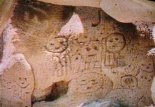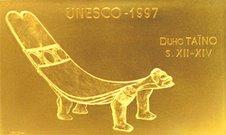By Sylvia Karayaturey RosarioFocus on the West Indian Manatee- (Trichechus manatus)
UCTP Taino News - On January 9, 1493, off the coast of Hispaniola, Christopher Columbus saw what he thought were three “mermaids” lifting their heads out of the water near Rio Yaque del Norte.
In his journal he wrote, “They are not so beautiful as they are painted; though to some extent they have the form of a human face.” His journal entry is believed to be the first documented sighting by a European of a manatee in the “New World”. While the English and Dutch named manatees “sea cows”, the common name comes from “
Manati” used by the Taíno and Carib peoples.
The manatee is as sacred to the Caribbean, Southeastern, and South American Indians as the buffalo is to the Plains Peoples. Not only did we consume the animal for food, just about every other part of the manatee was also used. Due to the lack of marrow, the Taíno and Carib used the bones to make spoons, weapons, body ornaments and spiritual objects such as pipes and cohoba spatulas (used to purge before ceremony).

In Southern Florida, manatee head bones have been found buried in the graves of tribal chiefs there showing the great reverence for the animal.
Some fossilized manatee bones found in Florida date back at least 45 million years. The leathery skin of the manatee was used to make shields, canoes, drum covers and even foot coverings. Fat and oil were used as fuel to generate light as well as for flavoring and preserving the meat.
When boiled or fried in its own oil, the meat could be preserved for a year or more. Manatee meat has been said to taste like veal, pork, or beef, depending what part of the body the meat was taken from. Because of this and the fact that manatees are friendly, therefore, easy to kill, manatee meat was largely sought after by the Europeans for their long sea voyages.
Currently, the Antilles manatee (one of two subspecies; the other being the Florida manatee) is considered to be the most endangered marine mammal in the area ranging from the Caribbean to as far south as Brazil.
The most common cause of death is directly related to human interaction. In recent years, 52.2% of the cases of manatee mortality were related to human causes like poaching, watercraft collision, and animals being shot or accidental capture. Only 22.2% were related to natural causes, mostly orphaned calves. Females usually have their first calf by the age of four. Normally they have one calf every two to five years, with the rare occurrence of twins. Under very optimal conditions, a female might be able to produce 12 to 14 young in her lifetime.
Manatees may live to be greater than 60 years old in the wild.
The
Caribbean Marine Mammal Laboratory (CMML), located in San Juan, Puerto Rico, is the only academic research laboratory in Puerto Rico and the Caribbean with license to rescue and rehabilitate whales, dolphins, seals, and manatees. The CMML was created in 1998 under a cooperative agreement between the Universidad Metropolitana and the non profit scientific organization
Caribbean Stranding Network (CSN). To date 15 manatees have been rescued, 4 of which have been reintroduced to the sea.
The success of rehabilitation depends on the severity of condition and health of the animal. The average success rate for manatees at CSN is 83.3%. Studies have also been conducted in the U.S. Virgin Islands, Trinidad, Venezuela, Jamaica, Columbia, Mexico, and the Dominican Republic. The CSN has been approached by the United Nations Environment Program (UNEP), to establish recovery plans in other Caribbean countries.
Photo: Manati with calves
===================











